Knots Training
Page
Webmasters note: Its been so long since I put this page
together that I can't remember where all of the illustrations came from. If you
recognize any of them, please send me a note and I'll gladly credit the author
or illustrator.
Thanks, MCG
Remember the 4:1 rule; The strength of the rope will be
diminished when a bend in the rope is less than 4 times the diameter. Thus, most
knots bend the rope at least less than this ideal formula. This is why strength
degradation is applied when a knot is tied in any rescue rope.
 Also known as
Full carrick Bend, Sailor's Knot and Anchor Bend. Beware! There are not many
knots with so much wrong drawings as this bend. The ends have to be on opposite
sites and the crossings always are alternating up/down/up/down... The Carrick
Bend is one of the best knots. Ashley states it is possible the nearest thing we
have to a perfect bend. It does not easily slip, not even if the rope is wet.
And it is always easy to untie, also after a heavy load. If used as a Hawser
bend in heavy material it is always seized and parceled to save wear.
Also known as
Full carrick Bend, Sailor's Knot and Anchor Bend. Beware! There are not many
knots with so much wrong drawings as this bend. The ends have to be on opposite
sites and the crossings always are alternating up/down/up/down... The Carrick
Bend is one of the best knots. Ashley states it is possible the nearest thing we
have to a perfect bend. It does not easily slip, not even if the rope is wet.
And it is always easy to untie, also after a heavy load. If used as a Hawser
bend in heavy material it is always seized and parceled to save wear.
The Josephine Knot
In the Macrame this knot is called the Josephine Knot. It is self evident the
Josephine knot is not seized nor pulled tight.

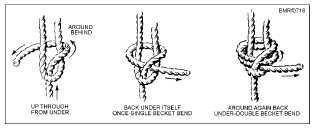
The chief value of the
Becket bend is its use in binding together two lines of different sizes. If there is a great difference in sizes or the strain on the line is to be great, always use a double Becket bend. To fashion a single Becket bend, you should make a bight in one line and run the bitter end of the other line up through it, as shown. Pass the end around behind both parts of the bight and back under itself. How you make a double
Becket bend by simply taking another turn around the bight. (These bends are also known as sheet bends.)
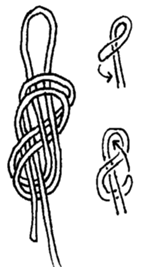
This is a very versatile knot most commonly used for attaching ropes to anchor
points. Most things that can be done with fancier knots (e.g. double loop knots
for a Y-belay) can also be done with a suitable combination of figure of eights.
If you only learn one knot, make it this one.
Strength: 55% (normal), 40% (abnormal)

The figure-of-nine knot can be used as an alternative to the figure-of-eight. It
is very similar to a figure-of-eight with just an extra turn before finishing
the knot. It is a little bulkier than the figure-of-eight but has greater
strength. Strength: 70% (normal), 55% (abnormal)
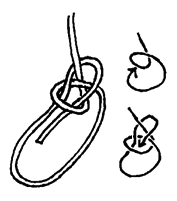
This can be used for tying a rope around a belay but is most often used for
tying the end of a safety line rope around a person when belaying them up a
climb or ladder.
This knot does have a tendency to loosen and can come undone
so it is a good idea to used a half hitch to secure the "tail" of the
knot to the loop. Strength: 50% (normal)

A good knot for belays or for tying rub points out of a rope.
Its main advantage is that the two strands of rope emerging from the knot are at
180 degrees to one another rather than emerging in the same direction as in a
figure-of-eight for example. This makes it a good mid-rope knot and good for
belays because it has greater strength than a figure-of-eight if the belay
fails.

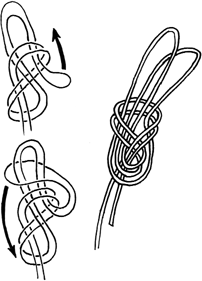
This double loop knot is most commonly used for rigging Y-belays. The nature of
the knot means that it is reasonably easy to adjust the loops by moving rope
from one of the loops to the other.
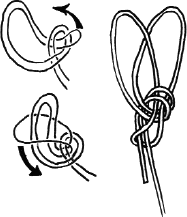
This is another double loop knot suitable for rigging Y-belays. It has the
advantage that is is a bit less bulky than the figure-of-eight on the bight.
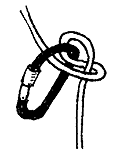
An excellent self-reversing friction knot suitable for belaying people when
climbing or using a ladder. It can also be used for abseiling and gives a
smoother ride than a stitch plate .
This one is worth learning for all those occasions when you forget your Stitch
plate or descender.
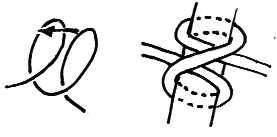
This simple knot is very useful for when you need a rapid
belay around an object or though a krab.

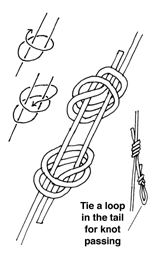
The standard knot for tying two ropes together. If used in the middle of a
pitch, a loop knot such as the figure-of-eight should be tied into one of the
"tails" of the knot for safety during knot passing.
The two knots that compose the double fisherman's should not be mirror images
of one another (i.e. they should have the same "handedness") otherwise
they won't stack properly.



This knot is excellent for tying in the middle of a
climbing rope, for lashings of many kinds -- anyplace a loop that leads fair
both ways in wanted. The method for putting it in is simplicity itself:
Take three turns of the rope round your hand, then:
1. Move center part (b) over right part.
2. Move new center part (c) over left part.
3. Move new center part (a) over right part.
4. Pull new center part (b) up to form the loop
5. For most satisfying results, remove hand before fairing or loading
knot."
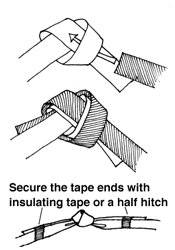
This knot is primarily used for tying tapes into slings for caving or climbing.
The ends of the tape emerging from the knot should be secured to the tape loop
using half hitches or insulating tape.
This knot is tied so that the load bearing tape emerges from opposite sides
of the knot so it will sit naturally when the sling is in use.
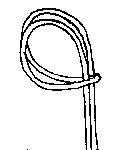
Often used for securing a tape more securely around a stalagmite or column. The
knot is weaker than just a loop of tape around the object, but it reduces the
chances of the tape slipping off.
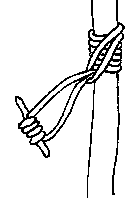
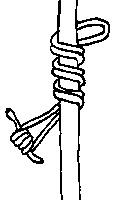

A classic prussic knot is shown on the left, and a Kleimheist prussic knot on
the right. Either of these, along with other prussic knots, can be used to prussic
up a rope. The rope used for the prussic-loop should be a fair bit thinner than
the rope to be climbed.
Return to
Technical Rope Rescue Page
Home
 Also known as
Full carrick Bend, Sailor's Knot and Anchor Bend. Beware! There are not many
knots with so much wrong drawings as this bend. The ends have to be on opposite
sites and the crossings always are alternating up/down/up/down... The Carrick
Bend is one of the best knots. Ashley states it is possible the nearest thing we
have to a perfect bend. It does not easily slip, not even if the rope is wet.
And it is always easy to untie, also after a heavy load. If used as a Hawser
bend in heavy material it is always seized and parceled to save wear.
Also known as
Full carrick Bend, Sailor's Knot and Anchor Bend. Beware! There are not many
knots with so much wrong drawings as this bend. The ends have to be on opposite
sites and the crossings always are alternating up/down/up/down... The Carrick
Bend is one of the best knots. Ashley states it is possible the nearest thing we
have to a perfect bend. It does not easily slip, not even if the rope is wet.
And it is always easy to untie, also after a heavy load. If used as a Hawser
bend in heavy material it is always seized and parceled to save wear.



















